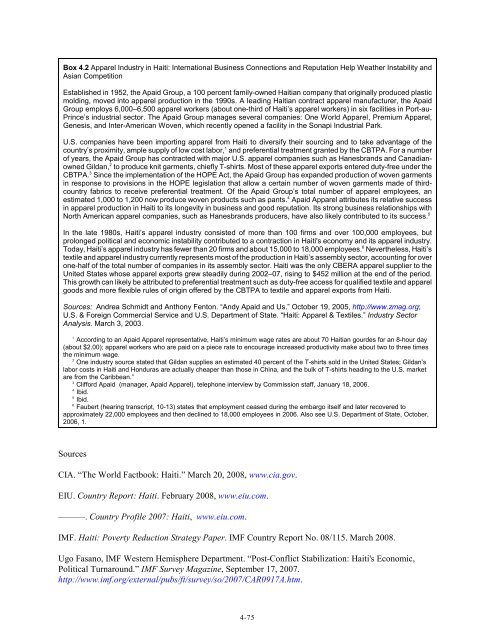Caribbean Region: Review of Economic Growth and ... - USITC
Caribbean Region: Review of Economic Growth and ... - USITC
Caribbean Region: Review of Economic Growth and ... - USITC
You also want an ePaper? Increase the reach of your titles
YUMPU automatically turns print PDFs into web optimized ePapers that Google loves.
Box 4.2 Apparel Industry in Haiti: International Business Connections <strong>and</strong> Reputation Help Weather Instability <strong>and</strong>Asian CompetitionEstablished in 1952, the Apaid Group, a 100 percent family-owned Haitian company that originally produced plasticmolding, moved into apparel production in the 1990s. A leading Haitian contract apparel manufacturer, the ApaidGroup employs 6,000–6,500 apparel workers (about one-third <strong>of</strong> Haiti’s apparel workers) in six facilities in Port-au-Prince’s industrial sector. The Apaid Group manages several companies: One World Apparel, Premium Apparel,Genesis, <strong>and</strong> Inter-American Woven, which recently opened a facility in the Sonapi Industrial Park.U.S. companies have been importing apparel from Haiti to diversify their sourcing <strong>and</strong> to take advantage <strong>of</strong> the1country’s proximity, ample supply <strong>of</strong> low cost labor, <strong>and</strong> preferential treatment granted by the CBTPA. For a number<strong>of</strong> years, the Apaid Group has contracted with major U.S. apparel companies such as Hanesbr<strong>and</strong>s <strong>and</strong> CanadianownedGildan, to produce knit garments, chiefly T-shirts. Most <strong>of</strong> these apparel exports entered duty-free under the23CBTPA. Since the implementation <strong>of</strong> the HOPE Act, the Apaid Group has exp<strong>and</strong>ed production <strong>of</strong> woven garmentsin response to provisions in the HOPE legislation that allow a certain number <strong>of</strong> woven garments made <strong>of</strong> thirdcountryfabrics to receive preferential treatment. Of the Apaid Group’s total number <strong>of</strong> apparel employees, an4estimated 1,000 to 1,200 now produce woven products such as pants. Apaid Apparel attributes its relative successin apparel production in Haiti to its longevity in business <strong>and</strong> good reputation. Its strong business relationships withNorth American apparel companies, such as Hanesbr<strong>and</strong>s producers, have also likely contributed to its success. 5In the late 1980s, Haiti’s apparel industry consisted <strong>of</strong> more than 100 firms <strong>and</strong> over 100,000 employees, butprolonged political <strong>and</strong> economic instability contributed to a contraction in Haiti's economy <strong>and</strong> its apparel industry.6Today, Haiti’s apparel industry has fewer than 20 firms <strong>and</strong> about 15,000 to 18,000 employees. Nevertheless, Haiti’stextile <strong>and</strong> apparel industry currently represents most <strong>of</strong> the production in Haiti’s assembly sector, accounting for overone-half <strong>of</strong> the total number <strong>of</strong> companies in its assembly sector. Haiti was the only CBERA apparel supplier to theUnited States whose apparel exports grew steadily during 2002–07, rising to $452 million at the end <strong>of</strong> the period.This growth can likely be attributed to preferential treatment such as duty-free access for qualified textile <strong>and</strong> apparelgoods <strong>and</strong> more flexible rules <strong>of</strong> origin <strong>of</strong>fered by the CBTPA to textile <strong>and</strong> apparel exports from Haiti.Sources: Andrea Schmidt <strong>and</strong> Anthony Fenton. “Andy Apaid <strong>and</strong> Us.” October 19, 2005, http://www.zmag.org;U.S. & Foreign Commercial Service <strong>and</strong> U.S. Department <strong>of</strong> State. “Haiti: Apparel & Textiles.” Industry SectorAnalysis. March 3, 2003.1According to an Apaid Apparel representative, Haiti’s minimum wage rates are about 70 Haitian gourdes for an 8-hour day(about $2.00); apparel workers who are paid on a piece rate to encourage increased productivity make about two to three timesthe minimum wage.2One industry source stated that Gildan supplies an estimated 40 percent <strong>of</strong> the T-shirts sold in the United States; Gildan’slabor costs in Haiti <strong>and</strong> Honduras are actually cheaper than those in China, <strong>and</strong> the bulk <strong>of</strong> T-shirts heading to the U.S. marketare from the <strong>Caribbean</strong>.”3Clifford Apaid (manager, Apaid Apparel), telephone interview by Commission staff, January 18, 2006.4Ibid.5Ibid.6Faubert (hearing transcript, 10-13) states that employment ceased during the embargo itself <strong>and</strong> later recovered toapproximately 22,000 employees <strong>and</strong> then declined to 18,000 employees in 2006. Also see U.S. Department <strong>of</strong> State, October,2006, 1.SourcesCIA. “The World Factbook: Haiti.” March 20, 2008, www.cia.gov.EIU. Country Report: Haiti. February 2008, www.eiu.com.———. Country Pr<strong>of</strong>ile 2007: Haiti, www.eiu.com.IMF. Haiti: Poverty Reduction Strategy Paper. IMF Country Report No. 08/115. March 2008.Ugo Fasano, IMF Western Hemisphere Department. “Post-Conflict Stabilization: Haiti's <strong>Economic</strong>,Political Turnaround.” IMF Survey Magazine, September 17, 2007.http://www.imf.org/external/pubs/ft/survey/so/2007/CAR0917A.htm.4-75
















